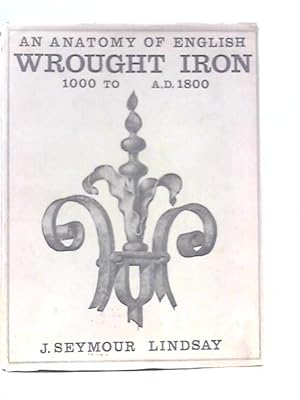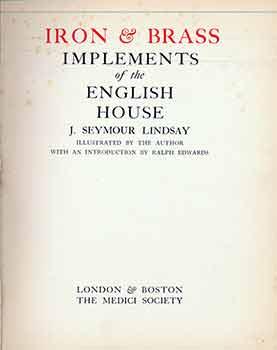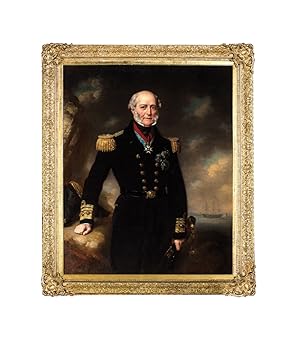Lindsay, John Seymour (7 results)
Product Type
- All Product Types
- Books (7)
- Magazines & Periodicals
- Comics
- Sheet Music
- Art, Prints & Posters
- Photographs
- Maps
-
Manuscripts &
Paper Collectibles
Condition
- All Conditions
- New
- Used
Binding
Collectible Attributes
- First Edition (1)
- Signed (1)
- Dust Jacket (2)
- Seller-Supplied Images (5)
- Not Printed On Demand
Seller Location
Seller Rating
-
New York's Architectural Holdouts
Published by Dover Publications, Inc., Mineola, NY, 1996
ISBN 10: 0486294250ISBN 13: 9780486294254
Seller: LEFT COAST BOOKS, Santa Barbara, CA, U.S.A.
Book
Paperback. Condition: Very Good. xvi, 172 pages, illustrations; 28 cm. Originally published: Holdouts! New York: McGraw-Hill, 1984. Near fine. Firm binding, clean inside copy. Light edgewear to wraps. Size: 4to.
-
AN ANATOMY OF ENGLISH WROUGHT IRON.
Published by Alec Tiranti, 1964., 1964
Seller: Hay Cinema Bookshop Limited, Hay on Wye, United Kingdom
First Edition
1st edition. Small 4to. vi + 57pp. + index. 178 b/w. illustrations. Original cloth. Pictorial beige d/w. lettered in black, slightly rubbed with two small tears to wrapp. at head of spine. US$21.
-
An Anatomy of English Wrought Iron
Published by Alec Tiranti, 1964
Seller: World of Rare Books, Goring-by-Sea, SXW, United Kingdom
Condition: Good. 1964. No Edition Remarks. 40 pages. Illustrated dust jacket over black cloth boards with lettering. Contains black and white plates. Clean pages and plates with light tanning and mild foxing throughout. Binding remains firm. Boards have mild edge-wear with slight rubbing to surfaces and bumping to corners. Lettering is bright and clear. Visible wear marks to boards. Unclipped jacket. Panels and spine have light edgewear with tears and creases. Moderate tanning and wear marks to flaps, panels and spine.
-
The Rose Annual, 1957. [Rose In Heraldry; Fragrances In Our Roses; Derriaghy; New Garden At Torquay; Madrid; Rome; Newark Rose Garden; Hybrid Pernetiana; Foliar Feeding; Old-Fashioned Roses; Mulching; Hulthemia Hybrids; New York]
Published by [Croydon : The Croydon Advertiser, 36 High Street] ; Produced by the Publications Committee of the National Rose Society of Great Britain, [1957], 1957
Seller: Joseph Valles - Books, Stockbridge, GA, U.S.A.
Hardcover. Condition: Very Good. 199 pp. ; illustrated ; green cloth with gold lettering and embossed designs ; no dustjacket ; "Produced by the Publications Committee of the National Rose Society of Great Britain" ; numerous articles on various subjects pertaining to the rose and its culture ; Contents: Patrons, Officers And Council -- Arrangements For 1957 -- The Presidents Page, By A. Norman, President -- The Rose In Heraldry, By The Late Captain H. S. Lecky, C.E. -- The Pragrances In Our Roses, By James Alexander Gamble -- Rose Gardens To Be Visited-Derriaghy, By Gordon Edwards, C.E.E. -- The New Garden At Torquay, By Ross Young, N.D.H., F.Inst. P.A. -- The New Garden At Madrid, By Ramon Ortiz Ferre -- The Rose Garden Of Rome, By Elvezio Ricci -- The Newark Rose Garden, By Eugene S. Boerner -- The Hybrid Pernetiana Rose, By C. C. Plowden -- Weather And Roses, By N. P. Harvey, M.A. -- The Things That Matter, By W. J. W. Sanday -- Foliar Feeding, By W. F. Bewley, C.E.E. -- How I Grow My Roses, By G. D. Burch, L. Hewlett, Seymour Heatley, Joan E. Fulford, -- Medal Blooms, By Leonard Hollis -- Book Review-Collems Guide To Roses, By Bertram Park -- Roses In The Smoke, By John Broadhurst -- On Rose Names, Byj. H. Wilding -- The Artistic Classes, By Julia Clements -- Origins Of The Rose, By Abel Belmont -- Miscellany, By A. Norman -- "My Rest Twelve Garden Roses", By Oliver Mee, O.B.E,W. H. Sumpster, Edgar M. Allen, C.M.G., A. Dick, B.Sc., M.D., H. G. Clacy -- Some "Old-Fashioned" Roses In My Garden, By Nancy Lindsay -- Dreaming Roses, By Sam Mcgredy -- Mulching As An Aid To Rose Culture, By F. W. Allerton, E.Sc. -- More Hulthemia Hybrids, By Nancy Lindsay -- Wild Hulthemosas, By G. D. Rowley -- Roses Under Glass, By Herbert Oppenheimer -- Obituary-Frank Mason -- The Spring Competition 1956, By H. G. Clacy -- Book Review-The Rose Book, By Wilhelm Kordes -- The Great Summer Rose Show, By Gordon Forsyth -- The Provincial Show, By A. C. L. Hellyer -- The Autumn Rose Show, By Roy Hay -- The Bristol Group, By A. E. Griffith -- The Trial Ground In 1956, By H. Edland -- Show Awards 1956 -- International Awards 1956 -- The Rose Analysis, By H. Edland -- Scientific Information, By John Ramsbottom, O.B.E., M.A., Dr. Sc. -- Accounts And Report Of The Council -- Monochrome Plates -- Albert Norman, President 1957 -- Derriaghy, The New Mcgredy Rose Garden -- Torquay, The New Municipal Garden -- Rome, The Municipal Rose Garden -- Madrid, The New Municipal Rose Garden -- New York, The Newark Rose Garden -- After The Great Snowstorm At Antibes, In February, 1956. -- A Branch Of The Largest Rose Tree In The World -- Arrangement Of Roses By Julia Clements -- The Largest Rose Tree In The World -- Colour Plates -- 'Faust' (Ron.) -- 'Montezuma' (H.T. Type) -- 'Highlight' (Flori.) -- 'Marigold' (H.T. Type) -- 'Circus' (Flori.) -- 'Dorothy Peach' (H.T. Type) -- 'Enterprise' (Ron.) -- 'Copper Delight' (Flori.) -- 'Elsinore' (Flori.) -- 'Jane' (H.T. Type) -- 'Golden Pleece' (Flori.) -- 'Mojave' (H.T. Type) -- 'Allgold' (Flori.) -- 'Oberon' (Flori.) -- 'My Lady' (H.T. Type) ; foxing, else VG. Book.
-
Iron And Brass Implements Of the English House.
Published by London: Medici Society., 1927
Seller: Wittenborn Art Books, San Francisco, CA, U.S.A.
Condition: Good. 4to. 211 pp. Hard Cover. Very Good. Gray cloth covered boards. Some shelf wear and soiling of boards. Spine sunned. Minor toning and foxing of some pages. Most pages fine. B&W illustrations and sketches throughout. Heavy volume, additional shipping fee may apply.Provenance: Ex-libris. Originally from the Oliver Collection of the Royal Holloway and Bedford New College Library. Library book plate, and other library markings present on spine and inside front cover.
-
Proceedings of the Second International Congress on Medical Librarianship: held in Washington, D.C. on June 16-22 1963 (Vol 52, No 1) (Bulletin of the Medical Library Association)
Published by Medical Library Association
Seller: Phatpocket Limited, Waltham Abbey, HERTS, United Kingdom
Condition: Acceptable. Used - Acceptable. Cover is a bit scuffed and creased. Your purchase helps support Sri Lankan Children's Charity 'The Rainbow Centre'. Ex-library with wear and barcode page may have been removed. Our donations to The Rainbow Centre have helped provide an education and a safe haven to hundreds of children who live in appalling conditions.
-
Portrait of Admiral Sir George Seymour as commander-in-chief at Portsmouth, with his flagship HMS Victory beyond
Publication Date: 1859
Seller: Hordern House Rare Books, Surry Hills, NSW, Australia
Signed
Signed and inscribed 'no 2 Admiral/ Sir G.F. Seymour *.*.*./ John Lucas.' (on reverse); oil on canvas, unlined 1428 x 1118 mm. A magnificent Pacific painting: the superb large portrait of Admiral Sir George Seymour as commander-in-chief at Portsmouth. This imposing full-length portrait depicts George Francis Seymour, not long after he had served as commander-in-chief of the Pacific Station, at one of the high-points of his career, as commander-in-chief at Portsmouth, with his flagship HMS Victory resting at anchor behind him and proudly wearing his naval uniform and all the regalia of his rank. "An intelligent and resourceful officer, successful in all his commands" (ODNB), Seymour had first shipped as a 10-year-old in 1797 under the command of Edward Riou, who had himself served with Cook on the third voyage and been captain of the Guardian when it wrecked en route for Port Jackson in 1789. After a brilliant naval career including some 20 years constant action against the French, Seymour became a key advisor to Parliament and King in the 1820s and 1830s, and a Lord of the Admiralty in 1840; frustrated by politics he was given another command when appointed to the 80-gun HMS Collingwood and sent to the Pacific to resolve a situation drifting towards open warfare with the French. During his command of the Pacific Station, and by insisting on diplomacy over armed conflict, Seymour would change the course of Pacific history with significant repercussions in Sydney and leading to substantial realignments within the broader Pacific region, and of the colonial relationship with Britain. Lucas, a prominent society painter of the early Victorian era, painted portraits of notables ranging from the Duke of Wellington to Queen Adelaide, and from the Duchess of Kent to Albert, Prince Consort. His accomplished and frequently very large portraits were much sought after - he "caught likenesses cleverly" (ODNB) - and his magnificent depiction of the Admiral in all of his splendour must have greatly pleased his subject. The Sir George Seymour, built in Sunderland, Tyne and Wear in 1844 by Somes Brothers, was named for him, an indication of his significance at the time he took up his post as commander-in-chief in the Pacific in the same year. She made one voyage transporting convicts to Australia and at least one carrying emigrants to Australia and one to New Zealand. A portrait of the ship is held by the Royal Museums Greenwich (may be sen online at collections.rmg.co). She was one of the "First Four Ships" to carry the Canterbury Association's first settlers to New Zealand. Significance to Australia Seymour's main task as defined in 1844 was to resolve the question of Tahiti and in particular the "Pritchard Affair", the tense stand-off between British and French naval officers about the colonial future of Tahiti. This had significant implications for "not merely Tahiti but the whole of the Pacific" (Bach, The Australia Station, p. 26). It is to be remembered that until the events which Seymour's careful diplomacy set in train, the Pacific Station was based in far-distant Valparaiso. Apart from the obvious significance of the Pacific Station in general, the repercussions of Seymour's activities in the Pacific would reshape the geopolitics of the Pacific, and certainly caused significant consternation in New South Wales; the recognition of French sovereignty over Tahiti was found to be so alarming that serious petitions were sent to Whitehall begging the government to reconsider. At the same time Seymour's actions impacted on the strong trade that had existed between Sydney and Tahiti since the days of the First Fleet. Seymour was seen as a masterful diplomat, and returned to England in something like glory. However, while a few in Britain felt that a wrong step had been taken, it was really only in the Pacific that his decisions continued to be questioned, and only in Sydney - where some local politicians and traders looking further into the future saw the likely impact of ceding Tahiti to the French - that there was a real reluctance to accept what was otherwise the fait accompli. Seymour not only witnessed, he was in a sense the midwife to, the creation of French Polynesia. His carefully conceived decision not to aggressively protect Tahiti against the French appalled policy hawks in Sydney, who made a strong case for armed intervention, petitioning Queen Victoria directly. In doing so they continued to express their anxiety about the apparent turning away of the British government. To the closest stakeholders in the Pritchard Affair and the situation in the South Pacific, the colonial government in New South Wales, British recognition of French authority in Tahiti was both alarming and even incomprehensible: the events provided an important catalyst towards self-government (the first Legislative Assembly was sworn in a decade later in 1856). One of the most significant long-term effects was that cannier politicians began to imagine a future in which Australia took the lead in the entire region, because they foresaw that by effectively cutting the southern Pacific in half, a major realignment would have to take place. The loss of Tahiti, and indeed the fading influence of Valparaiso as centre of command for the Pacific Station, left the field open for Sydney. This may have been well understood by the Admiralty: in 1848 Sydney was upgraded to hosting an "Australian Division" of the East Indies Station (prior to that having been only a remote outpost of the East Indies Station). Just a decade later, in 1859 the Australia Station was inaugurated. The shape of the Pacific had changed). . Provenance: Commissioned by Admiral Seymour personally, given by him to his third daughter Emily Charlotte (1825-1892, who had sailed with her parents on the Collingwood to the Pacific). She married William Richard Ormsby-Gore (second Baron Harlech, 1819-1904) in 1850. The portrait was exhibited at the Royal Academy in 186.





![Seller image for The Rose Annual, 1957. [Rose In Heraldry; Fragrances In Our Roses; Derriaghy; New Garden At Torquay; Madrid; Rome; Newark Rose Garden; Hybrid Pernetiana; Foliar Feeding; Old-Fashioned Roses; Mulching; Hulthemia Hybrids; New York] for sale by Joseph Valles - Books](https://pictures.abebooks.com/inventory/md/md1362950578.jpg)

